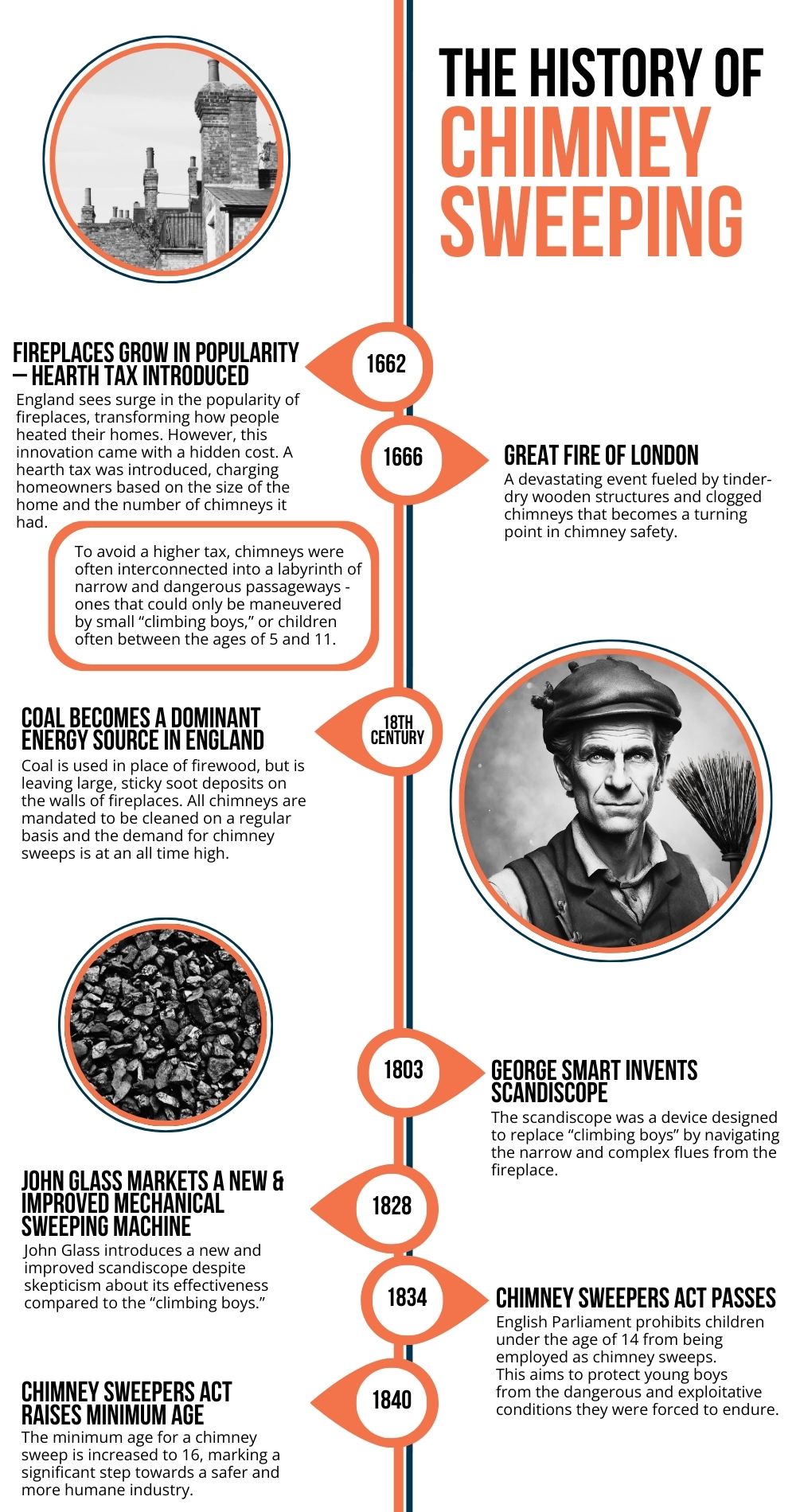For centuries, the crackling warmth of a fireplace has been a symbol of comfort and home. In fact, the early Romans were the first to make a significant switch from open fire pits in the center of the room to fireplaces that were more effective for heating buildings (and being able to cook indoors).
It wasn’t until 16th century England, however, that the trend of fireplaces and chimneys truly caught on. This innovation revolutionized home life, but it also created a new – and sometimes dangerous – necessity: the chimney sweep.
When you picture a chimney sweep, the first thing that likely comes to mind is a sooty fellow with a top hat and a mischievous grin, scaling a chimney with a brush in hand. And, thanks to Mary Poppins, cheerful sing-alongs and magical adventures might also come to mind.
But the history of chimney sweeping is far less “supercalifragilisticexpialidocious.” The history of the chimney sweep profession is actually rather dark…and filled with the unthinkable.
Chimney Sweep Boys: The Early Days of Chimney Sweeping

Fueled by the growing popularity of fireplaces in 17th-century England, people yearned to have fireplaces in each room of their house to use as a reliable heat source. However, this very innovation brought an unexpected burden – a new hearth tax. It was a very high tax at the time that was based on the size of the home and the number of chimneys the house had. To avoid this, many builders would connect the flues of the new fireplaces to the existing chimney, creating a labyrinth of small, dark tunnels inside the home.
It wasn’t until the Great Fire of London in 1666, a devastating event fueled by tinder-dry wooden structures and clogged chimneys, that people became more aware of the dangers of poorly maintained chimneys and inadequate building codes.
However, a new challenge arose with the growing popularity of burning coal in place of firewood. Coal left behind large, sticky soot deposits, known today as creosote, on the walls of the fireplace. If people neglected to get their chimneys and fireplaces cleaned on a regular basis, the chimney wouldn’t vent harmful smoke and fumes properly. For obvious safety reasons, all chimneys were mandated to be cleaned on a regular basis.
The demand for a chimney sweep was greater than ever. However, the much narrower and compact design of multiple flues interconnecting in one house created a major problem – cleaning these chimneys became nearly impossible for the average-sized adult. Tragically, the solution to this problem became an unthinkable one: using small boys or “climbing boys.”
Orphans or poor families that sold their children to a chimney master were usually between the ages of 5 and 11, sometimes even as young as 4 years old. These boys were forced to climb through chimneys in exchange for a meager existence, only being given a place to sleep, food, and water as means of payment. If they were too afraid to climb in the chimney, the chimney master would help “motivate” them by lighting a small fire under them so they would complete the job faster – which is where the saying “to light a fire under someone” originated.
Many boys’ bones became deformed after being crammed into uncomfortable positions. Some even lost their lives after suffocating or becoming trapped. These harsh conditions took a brutal toll on their health, with many child chimney sweeps succumbing to lung infections and developing the first recorded industrial cancer – scrotal cancer.
Many people recognized how cruel this was for children to have to perform such dangerous jobs, but it wasn’t until 1834 that the Chimney Sweepers Act was passed by the English Parliament. This outlawed any child below the age of 14 to clean chimneys, and in 1840, the minimum age was raised again to 16.
Other Ways Chimneys Were Cleaned in the Old Days
While child labor remains a dark stain on the history of chimney sweeps, it wasn’t the only method employed in the old days. Necessity (and perhaps a clear conscience) often led people to get creative with chimney cleaning. Some other unconventional ways people tackled the task of keeping their chimney clean includes:
- “The Blacker the Goose, the Cleaner the Flue”: This bizarre practice involved tying a rope around a goose’s neck and forcing it to fly up the chimney. It was believed at the time that the flapping of the goose’s wings would dislodge the soot.
- Rope and Ball System: Some people used a system with a heavy iron ball attached to a rope and brush. The weight of the ball would help push the brush down the chimney, scrubbing away the soot as it went.
- Natural Resources: Some were known to tie big bunches of holly leaves to a rope, then pull them up the flue in an effort to get any stuck-on soot and creosote lodged free.
How History Influenced Modern Day Chimney Sweeping
Although horrifying, the dark history of child labor in chimney sweeping served as a catalyst for change. It spurred inventors like George Smart and John Glass to develop safer and more humane methods for cleaning chimneys. Smart’s mechanical sweeping machine, the scandiscope, likely inspired Glass to focus on marketing and refining these new tools, laying the groundwork for the professional chimney sweep industry we know today.
If you’re looking to keep your fireplace safer and ensure a cozy winter season, contact Integrity Chimney Service today. We offer professional chimney cleaning services using the latest techniques and prioritize safety and customer satisfaction with every job. Give us a call at 570-221-4113 or request an appointment on our website.

Recent Comments